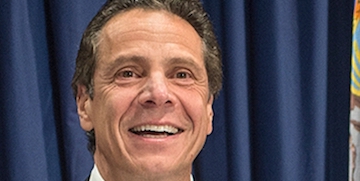Gov. Cuomo–we will keep on top to see what the promised investigation reveals. Photo: Wikimedia Commons.
[COVID-19 And African Americans]
The numbers reflect the harsh reality of the disparate health care in various zip codes of the City of New York. The highest recorded death rate due to corona virus was in Canarsie-Flatlands neighborhood. High death rates are also recorded in poor Black and Brown neighborhoods in the Bronx and Queens. The zip code in Lower Manhattan where the powerful and the affluent live recorded 0 deaths per 100,000. Park Slope, the gentrified neighborhoods of Downtown Brooklyn and Prospect Heights also show low fatality rates at 42 per hundred thousand, according to New York Department of Health data cited by the New York Times on May 18.
We often hear that the corona virus is the great equalizer. I beg to differ. The virus knows where the vulnerable population is, and I’m not talking about the vulnerability of the elderly, or people with underlying diseases either. It is a class and race defined vulnerability.
COVID-19 laid bare for all to see the lie and hypocrisy of our elected officials, particularly Mayor Bill de Blasio who ran on a platform of addressing disparities in health and education among New Yorkers.
New York should move away from being “A Tale of Two Cities,” de Blasio declared, when he first ran to become mayor of New York. Here we are two terms into his mayoralty and New York is more so a tale of two cities, except that it is the worst of times for the poor and people of color.
Most of the dead during this pandemic have been the working poor, the frontline essential workers who were needlessly exposed to the ravages of the pandemic in order to keep the rest of us fed while sheltering in place.
These frontliners have been bagging our groceries, delivering our food, our mail and packages, keeping New York City’s busses and subways running, and taking care of the elderly in nursing homes while the rest of us could afford to stay home and be safe.
These workers are for the most part Black and Brown and the undocumented. They were young and old, otherwise healthy before they were felled by the virus simply because they had to be out there to do what they do because they had no alternative. They died so the rest of us could live. They were not adequately protected nor were they compensated with hazard pay.
Just reading about COVID-19’s toll on vulnerable communities is traumatic. “Virus is Twice as Deadly for Blacks and Latino People than Whites in New York City, ” screamed the headline in a New York Times article on April 6.
New York’s Gov. Andrew Cuomo vowed to investigate why more African American and Latinos are affected. That provided the sound bite for the day on his daily briefing on April 8. I am not aware of any investigation under way as yet. It will be back to business as usual once the danger of the pandemic abates unless we stay on top of the issue.
The disparities in the impact of diseases along racial lines is nothing new. Racism pervades the history of American health care system. Harriett Washington in her well-documented “Medical Apartheid,” has chronicled the legacy of slavery and Jim Crow laws in American “health care,” –if one can call it that–delivered to people of African descent over the existence of the republic.
One only need read about Dr. Marion Sims’ diabolical human experimentations using enslaved Africans to perfect the surgical techniques that gained him international fame as father of modern gynecology and obstetrics. His statues adorn medical schools around the country and was prominently displayed in Central Park until it was finally removed–it’s a topic I wrote about in Black Star News on Sept 24, 2018.
Race was also a factor in what came to be known as the Mississippi Appendectomy, a practice of surgical sterilization of Black women who were admitted to the hospital for other surgical procedures. My own experience in the medical field spanning close to 50 years in the U.S. has allowed me to witness up close how racist attitudes and practices affect the health of the Black and Brown citizens of the City.
In the 1970s, when I was in residency training there were reports of high number of unnecessary hysterectomies in the inner city hospitals. I recall one attending physician being quoted then that the residents needed the surgical experience during their training. I call that diabolic system the Northern version of the Mississippi appendectomy.
As medical residents we were trained that Black people tended to suffer more from hypertension–often malignant–and diabetes.
Black women often showed up in emergency rooms with advanced stages of breast cancer. They were often blamed for not taking care of themselves; not seeking medical care early. No one asked them why, or whether the prevailing fee-for-service system allowed them to afford private primary care.
Genetic predisposition was often cited as one of the convenient reasons for the high prevalence of diseases in the minorities. Subsequent studies would show that one’s access to health care was the major determinant for the disparities.
Heart disease is the leading cause of death in the United States. The CDC surveillance report, March 30, 2018, reviewed death rates from heart disease from 1968 to 2015. The death rates among Blacks and Whites were similar in 1968 at the beginning of the study. The death rates were steadily falling since then but the rate of decline lagged in Black people compared to Whites over the duration of the study period. Why?
The reasons are multifactorial. One groundbreaking study I found in the article in the AMA Journal of Ethics, June 2014 by LaPrincesa C. Brewer and Lisa A. Cooper was most compelling. They concluded: “Exposure to racial/ethnic discrimination, a psychosocial stressor contributes to observed cardiovascular and care disparities”
Several studies have also shown that Blacks are less likely to be admitted to hospital with revascularization capabilities or be brought to hospital within the window period of 90 minutes where intervention might limit the damage from cardiac event.
Prostate cancer is another disease that is felt to be particularly aggressive in Black men. However a VA study where access to care for veterans is available showed no disparities in death rates when there is equal access, as reported by NIH on Feb. 18, 2020.
Attitudes among medical colleagues toward minority patients is also another not so subtle manifestation of discrimination. The case of sickle cell disease sufferers is an example.
These patients, almost all exclusively people of color, suffer from intense pain during a sickle cell crisis and need adequate amount of narcotics along with other interventions to make them feel better. Their pain is often undermanaged with pain medication. Their requests are often dismissed as the behavior of drug addicts.
Anyone who has taken care of such patients knows that they would not want to stay in the hospital a minute longer and want to go home as soon as they felt better.
The silver lining if there is one, of the current coronavirus COVID-19 pandemic is that it has exposed the inadequacy of our corporatized health system. Coupled with racism, the effect weighs heavily on the poor and people of color.
If Gov. Cuomo is serious about investigating the disproportionate death rate in poor and Black neighborhoods, he needs to explain why the testing for coronavirus lagged behind in these neighborhoods even after the disparities were made known.
Any investigative body he sets up needs to have in addition to experts in public health field, also representatives from grass roots organizations, labor, women, youth, and civil society from the affected community.
This is the most effective way to address the whole area of socioeconomic injustice, the deplorable state of education, and health care in minority neighborhoods.
Such a body would then recommend corrective measures to be implemented expeditiously. An independent watch dog agency needs to be established to monitor how the state and city governments are in compliance, by putting the necessary resources into implementing the recommendations. People must be held accountable if they fail to deliver on the recommendations.
Enough of the platitudes and hollow promises already.
Mohammed A. Nurhussein MD is a retired physician. He was professor of Medicine at Downtown Medical Center.












